Project controls keep a project on track. When things aren’t quite right, and a project begins to go sideways, the controls give you an early warning sign so you can adjust and get things back in order as quickly as possible.
In this article, I go over a handful of project control documents, templates, and checklists you can use to control your project and start handling these types of issues in a systematic manner.
NOTE: I did not say that you’ll be able to eliminate these issues. You won’t!
Projects rarely go as planned. Things change on a constant basis, whether it’s your team members, client expectations, or unanticipated complexities that affect your plans. Project managers are responsible for minimizing the chances of risks becoming issues, but it’s also our job to address issues when they do occur.
A NOTE ABOUT TEMPLATES
You can get templates to help you roll out these project controls—you’ll find them in DPM Membership, along with 100+ other project templates, documents, samples, ebooks, checklists, and workshops.
What are Project Controls?
Project controls are the actions you take as a project manager and the documentation you use to keep your projects on track. They are a set of tools that help you produce project deliverables successfully.
See the following project control definition from the Project Management Institute (PMI):
A project control system aims to minimize the gap between project planning and project execution to achieve project aims, i.e., cost, time, and content.
In practice, project controls focus on monitoring project key performance indicators (KPIs), such as cost and schedule, which ultimately tie in with scope and delivery. By keeping an eye on real-time metrics, project controls can help project managers anticipate issues and opportunities.
For example, if your project is ahead of schedule and/or below cost, you can afford to spend a little more to enhance quality. If the budget is looking tight, you can identify ways to cut corners in other areas, such as by substituting a lower cost resource to produce future deliverables.
Project Controls vs. Project Management
Now that I’ve defined project controls as a set of tools to keep a project on track, you may be wondering how that differs from project management.
The key difference here is that the scope of project management is much broader.
Instead of narrowly focusing on KPIs to monitor project success—i.e. project controls—project management also has to do with managing stakeholder relationships and producing quality deliverables. These items are integral to a successful project and go way beyond project performance tracking.
Is there a difference between a project manager and a project controller?
Yes. In some organizations, a project controller is like the right hand of the project manager.
The project controller is more focused on project metrics, tracking, controls, and analysis, while a project manager is more focused on the project team, how project work is executed and to what quality standard, and managing relationships with clients and stakeholders.
Typically, digital project managers serve as both project managers and project controllers.
Why Project Controls are Important
Project management’s so-called iron triangle—scope, schedule, and quality—can sometimes get you into sticky situations. You’ve undoubtedly had conversations like these:
Team: “Surely the client would be much happier if we could have just two more days to finesse this…”
Client: “I like the approach here, but can you sharpen your pencil and work out a way to do this with half the budget?”
This balancing act is one of the hardest tasks for us as project managers.
On the one hand, we have to deliver a product that makes the client happy. On the other hand, we should always be behind the team and allow them to put their best work forward.
Project controls allow you to go into these types of difficult client conversations well-prepared. Here are some of the benefits of project controls:
- Help you make informed decisions regarding the optimal balance between cost, schedule, and quality
- Mitigate the risk of scope creep by showing the impacts of taking on additional tasks
- Help you get ahead of unforeseen costs
- Allow you to formulate contingency plans to address schedule variances and/or resourcing challenges
- Serve as a tool for managing stakeholder expectations regarding project outcomes.
8 Examples of Project Controls to Tame Your Project Chaos
Now that I’ve covered project controls and their benefits, here are 8 practical examples of project controls—including templates—that you can apply to your projects.
- Project planning documentation
- RACI chart
- Communication plan
- Work breakdown structure
- QA checklist
- RAID log/risk register
- Status report
- Change request
1. Project planning documentation
Stop here. Go no further into this article if you don’t have some kind of essential project planning document yet. That’s the basis for your controls—it’s a record that shows what you intended for the project so you can see if it’s tracking according to plan.
I won’t go into deep detail about how to make and use these documents here since that’s outside the scope of the article. I’ll simply cover what they are and how to find more information.
Project planning documents include:
Project brief
This covers the who, what, when, why, how, and other essentials of your project so you can build a solid foundation for execution

Get a pre-made project brief template, including prompts to help you think through how to fill out each section, and a sample showing you what a completed version looks like.
Project budget/cost estimate
To determine whether your project is on or below budget, you need an original cost estimate to use as a baseline. Here’s a project budget cost estimation guide that you can use to put together an estimate.
Timeline, project plan, schedule, and/or Gantt chart
As with the project budget, you need a baseline to determine whether you’re tracking against plan. A project plan, including a project schedule, is your most basic tool for controlling your projects—and setting them to be controllable in the first place.
Read our guide to creating a project plan here.
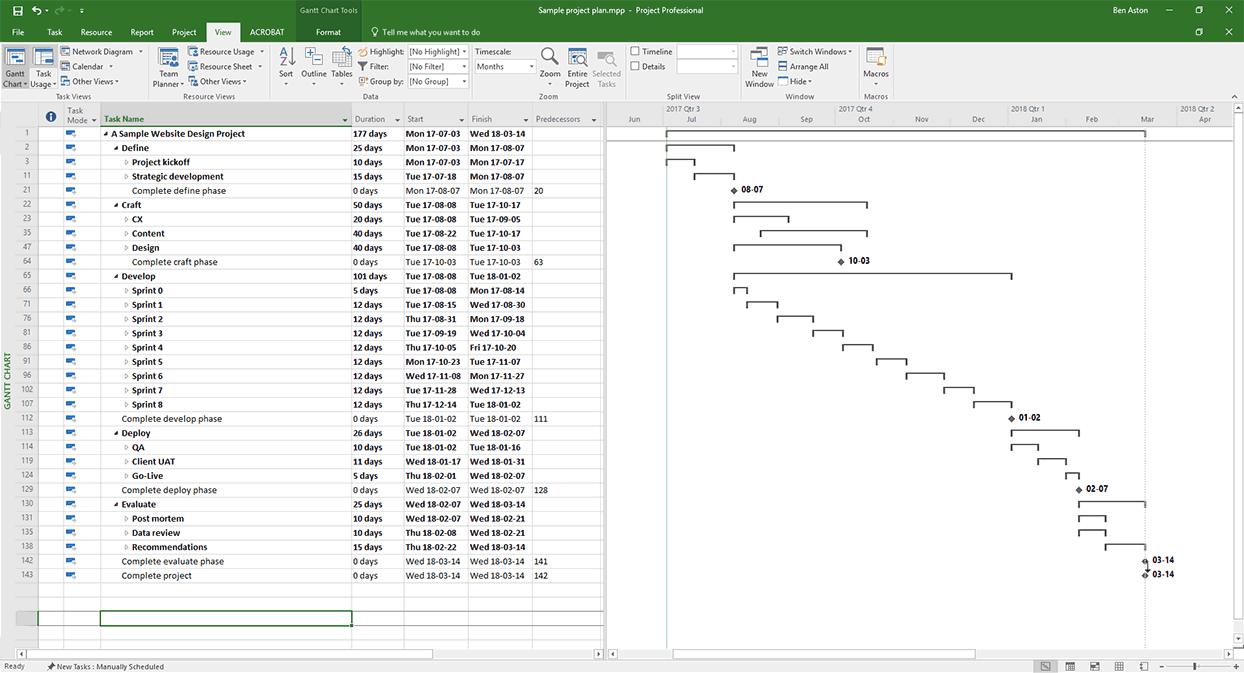
If you’re curious to see what some real project timelines look like, you can find timeline examples in DPM Membership.
Statement of work
Your statement of work contains a lot of information to help you set up controls for the rest of your project. If you’re new to the concept, you can start with DPM’s ultimate guide to writing a statement of work.
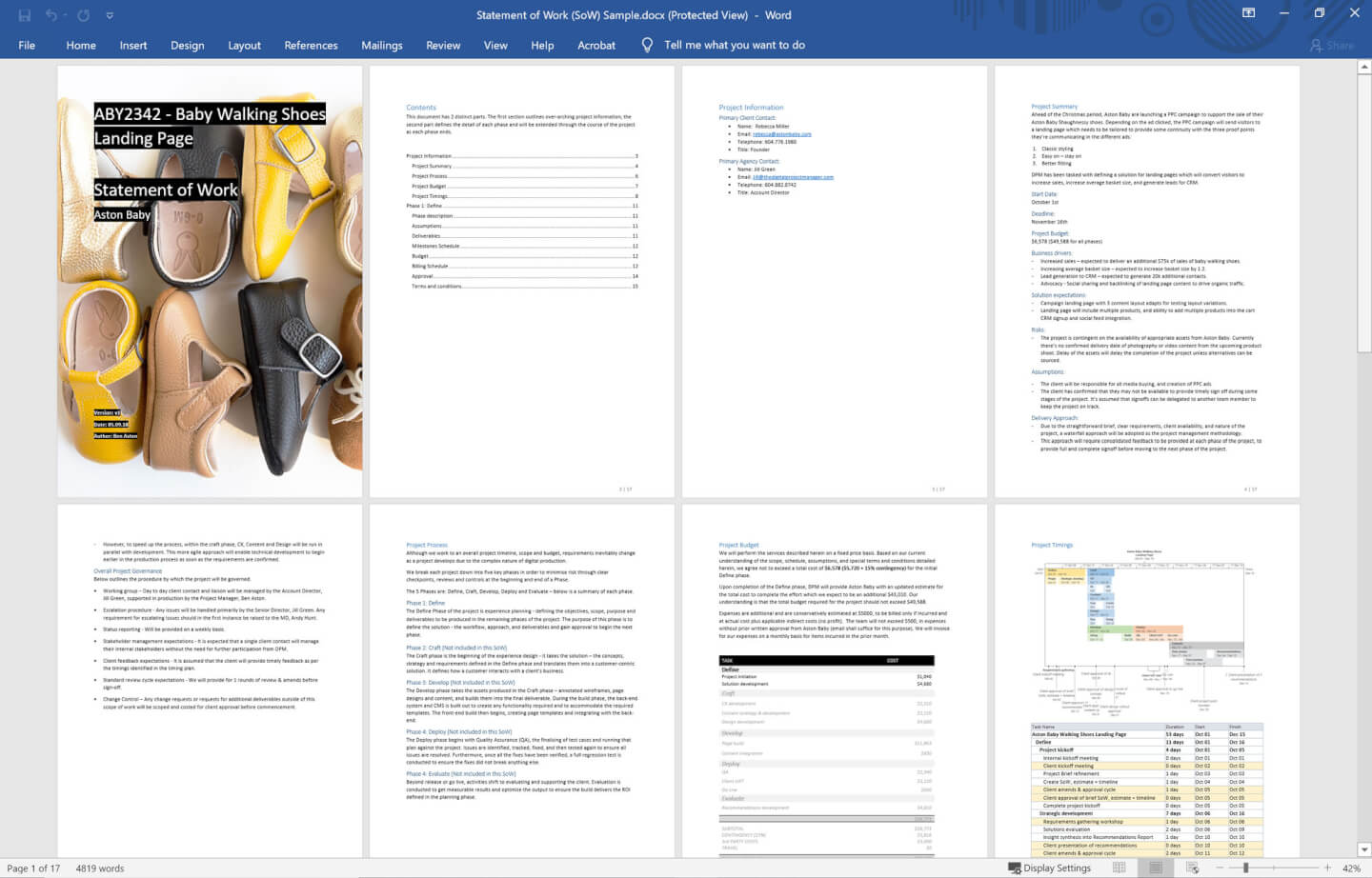
2. RACI chart
RACI is an acronym for responsible, accountable, consult, inform. Project managers use a RACI chart to assign roles and responsibilities for project tasks and decision making.
When do you need it?
A project with complicated decision making or approval workflows may require a RACI chart. A RACI chart helps, in particular, if there is a conflict around responsibility.
It can be difficult to master RACI charts but, once you do, you’ll find that it can help prevent pointing fingers later on.
A RACI chart is useful because it documents who is responsible for completing a particular task and who needs to be informed of status. It can be a solution for a probable delay in decision making or an uneven distribution of workload.
Here are the definitions of the various terms on a RACI chart:
- Responsible: The person performing the task. This person takes primary action and presents the deliverables.
- Accountable: The person that ensures that the task or job is completed. They are not necessarily the one executing the task, but they sign off on the final product.
- Consult: The person or people that provide information, advice, or feedback on the task.
- Inform: The person or people that must be aware of critical deadlines and project progress, as they have a stake in the outcome.
How do you use it?
To use a RACI chart, outline the key tasks to perform on the project. Then, list the project team members and other stakeholders that are involved. In each column and row of your chart, assign a RACI letter (responsible, accountable, consult, or inform) to explain their role.
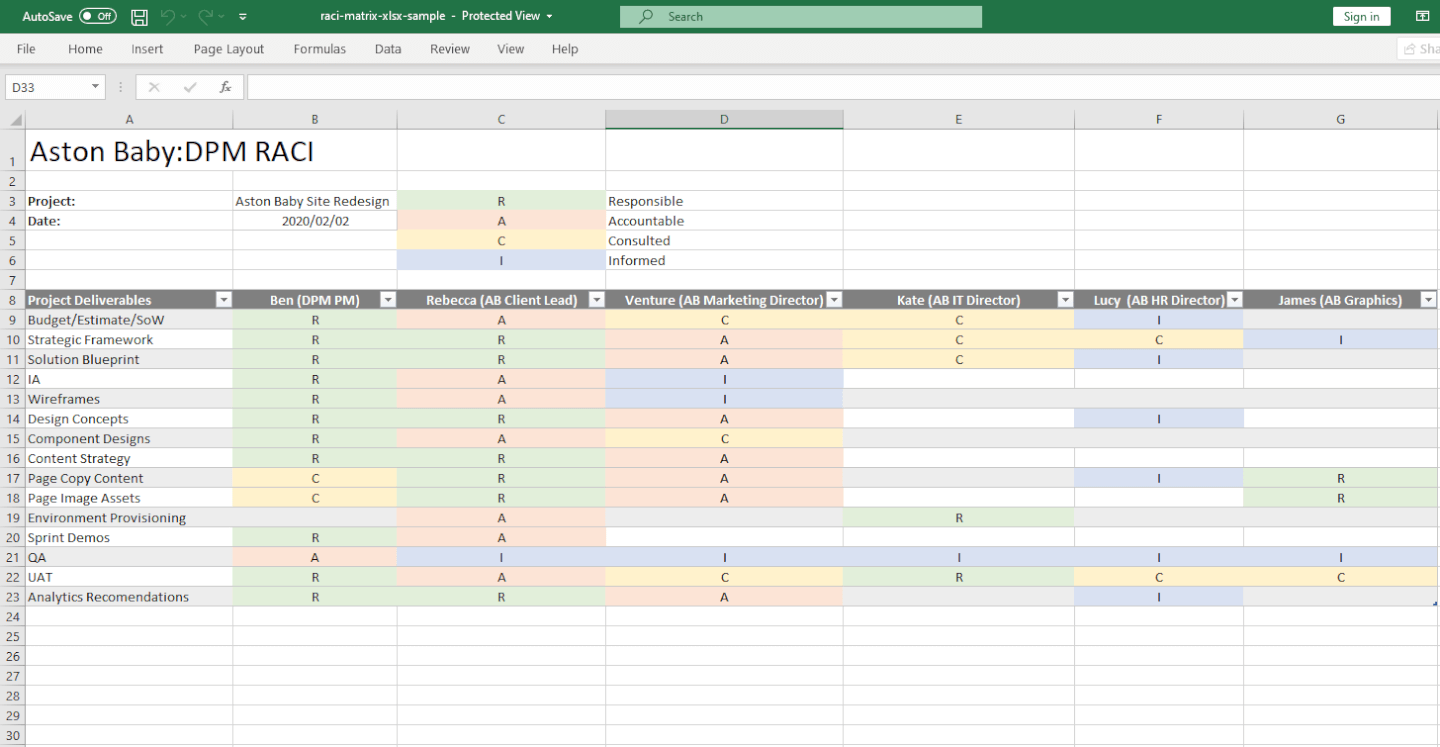
RACI Chart Template & Samples
DPM Membership offers multiple RACI resources:
- RACI template
- Filled-in RACI samples
- Workshop: Master RACI Charts in 30 Minutes
- RACI checklist to help you do it right
- RACI cheat sheet
3. Communication plan
A communication plan is a document that lists project stakeholders and defines communication channels by preference and priority level.
When do you need it?
You need a communication plan if your project involves multiple individuals or groups that need to be kept in the loop throughout the project life cycle. So, basically, you need a communication plan for every project.
Remember that the communication plan is for your own benefit as much as it is for anyone else. The communication plan determines how often you communicate with the client and lets them know your intentions before the project even starts.
How do you use it?
A communication plan defines who on the project should be connected, at how frequency, via what mechanism, and how often. Creating a communication plan helps you define communication goals for the project, document stakeholder information, and pinpoint what information to share.
Communication Plan Template & Sample

4. Work breakdown structure
A work breakdown structure (WBS) decomposes project scope into the discrete tasks required to fulfill project objectives and complete assigned deliverables. It’s one of the most important project controls because it visually represents the work that team members must complete and is therefore a good mechanism for tracking progress against project requirements.
When do you need it?
You need a WBS to clarify roles and responsibilities, help ensure tasks are completed on time and are of high quality, and track project activities. It’s critical that you develop the WBS during the project planning phase to ensure that stakeholders have a common understanding of the work required to complete the project.
How do you use it?
To use a WBS, you identify the project deliverables and then break down those deliverables into the tasks required to produce them.
Once you have a high-level overview of deliverables and supporting tasks, sequence the work. Estimate the level of effort required per task, and schedule the work accordingly. Then, make a resource management plan for how you’ll staff the work based on level of effort, and share it with stakeholders to gain buy-in.
WBS Template & Sample
I’ve included a free downloadable WBS template and sample WBS that you can use on your projects. To edit the file, download it as an XLSX file and use it within Google Sheets or Excel.
5. QA checklist
A quality assurance (QA) checklist contains important items relating to project processes, testing methodology, and/or product categories.
When do you need it?
A project manager assumes responsibility for errors or missed items. QA is an essential process to ensure that everything is working as it should, and nothing important has been missed.
A project manager should take a lead role in the QA process to ensure that team members properly prioritize and log issues using a QA checklist. The project manager then works with team members to assign a responsible party to address each item on the list. That person tests, retests, implements the fix, and records the end results.
A QA checklist is often broken down into different project categories or phases that require different QA checks. The checklist catalogs the required testing steps for each product category, such as requirements or security.
How do you use it?
A QA checklist breaks down your project into categories or phases, each of which may require independent testing by various specialists across your team.
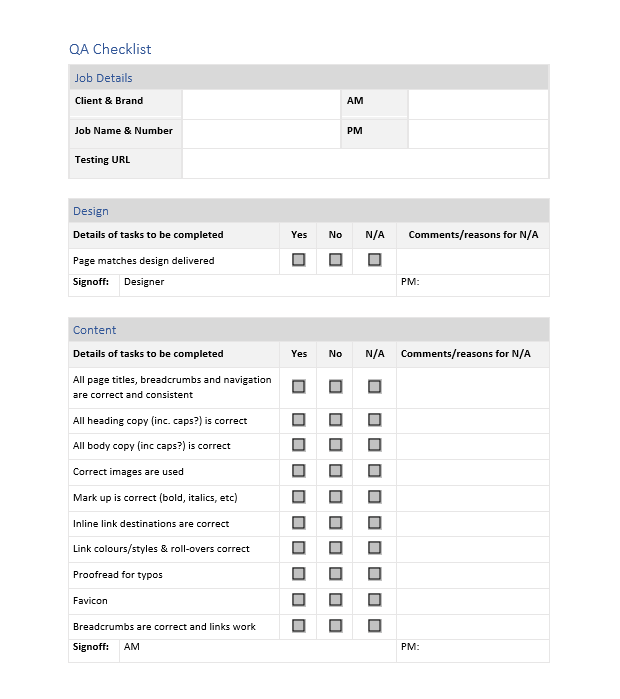
QA Checklist Template
The DPM QA checklist is a quick reference to make sure the people responsible for QA on your projects have verified the content and functionality align with the project’s quality standards.
6. RAID log/risk register
A RAID log is a tool for capturing and managing risks. It’s a risk management document in which you record risks, assumptions, issues, and dependencies.
Check out our workshop on managing risk here.
When do you need it?
RAID logs are particularly helpful for projects in complex environments with many stakeholders, such as third parties, steering committees, IT departments, or contractors.
Status reports usually have a high-level focus, while RAID logs take things a step further to focus specifically on risk management. It’s a document that holds team members and other stakeholders accountable by accurately tracking risks along with assigned actions.
A RAID log notes any risks or potential flags, creating a culture of proactive openness. It’s incredibly helpful for exposing multiple perspectives on your project processes (ex. Does the IT gating process take 4 weeks? Are the allocated number of revisions sufficient?)
If you anticipate a problem, document it in your RAID log and talk about it in your status meeting. Assign an owner to each risk to formulate an action plan for how to address it (even if that answer is to do nothing and accept the risk!)
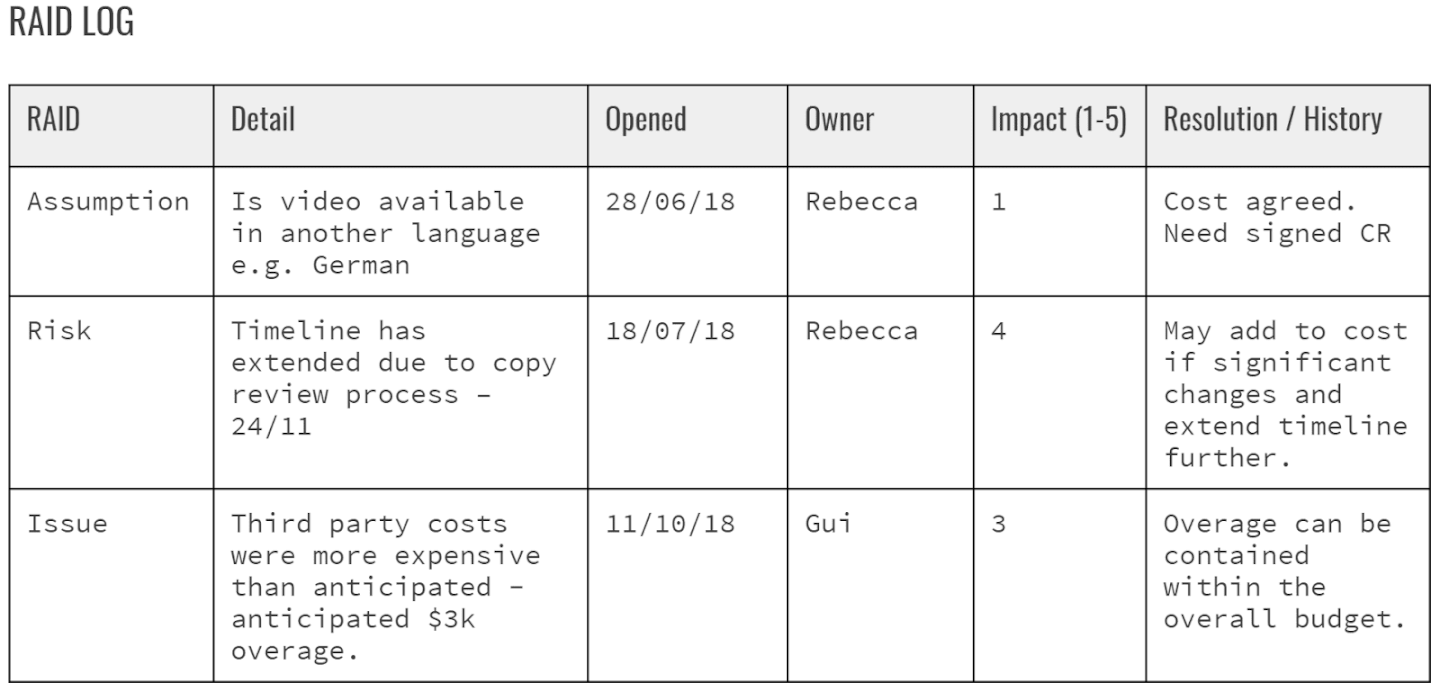
How do you use it?
You should start a RAID log at the beginning of the project and update it in regular meetings with the client’s input. It’s important that you also use it to document decisions. A RAID log should include:
- Risks: known threats or opportunities that haven’t yet materialized
- Actions: action items from meetings, ongoing tasks, etc., including assignees
- Issues: ongoing challenges that may threaten project success
- Dependencies: tasks that must be completed before another task can begin or finish.

RAID Log Template
Get a jumpstart with:
- RAID log template in a premade spreadsheet
- RAID log sample to show what a RAID log looks like when filled out for a website redesign project
- Risk management webinar
Access these by becoming a DPM Member.
7. Status report
A status report ensures involved parties have a clear understanding of where the project is at.
When do you need it?
Being consistent with status reports is key for transparency and effective management. It’s essential to have an updated status report prepared on a consistent cadence that stakeholders can come to expect.
To establish a proper reporting cadence, aim for weekly project status reports. While you can deliver asynchronously, it is sometimes helpful to hold a synchronous conversation with your client. These meetings don’t need to belong—30 minutes might be plenty—but it’s a good way to establish a relationship with your client and build trust.
If possible, hold status meetings face to face in a more casual setting. Don’t simply talk about the project; instead, show an interest in the other things happening with your client’s company and share some of your portfolio highlights. These conversations can sometimes generate business opportunities that you wouldn’t have heard about otherwise.
How do you use it?
Some clients expect to see detailed hourly reports, while others prefer the big picture. At a minimum, a status report should include the following:
- Total project cost, budget allocated, budget remaining
- Monthly cost/burn rate
- What was achieved in the past month and what is planned next
- Updates on timeline
- Action items
- Risks, blockers, and decisions.
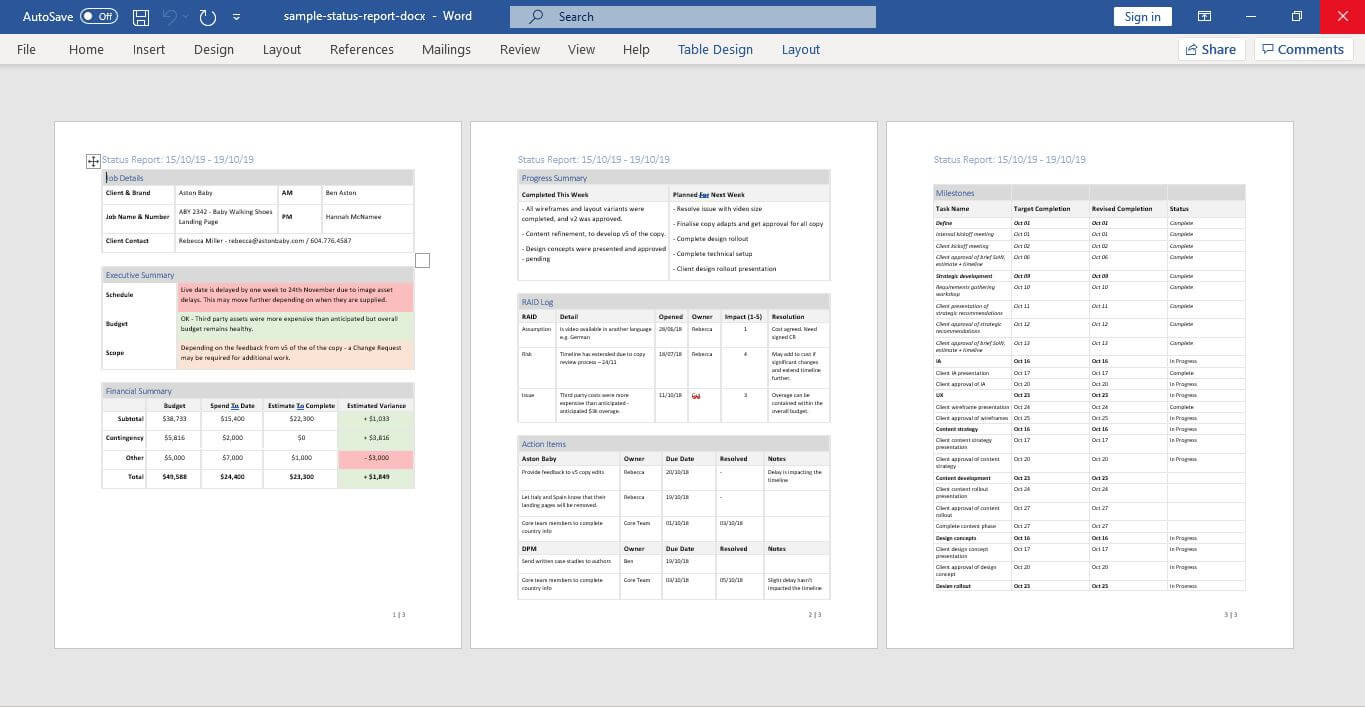
Status Report Template & Sample
Present your project status using a status report template. Use our sample status report as a guide and simply fill in the sections for your executive summary, financial summary, progress, RAID log, action items, and milestones.
8. Change request
A change request outlines and defines a change in scope that occurred in the project relative to the initial statement of work or cost estimate.
When do you need it?
Both parties must formally acknowledge and agree to a change request. Change request documentation should explain the change and its rationale and the impacts to project budget and timeline.
While it’s a common misconception that change requests are negative, they are simply a part of effective project management for communicating that the anticipated scope has changed. Especially when this happens later on in projects, these scope change decisions can be made with confidence and will result in better outcomes.
It’s essential to educate the client on the change request process early on so everyone’s familiar with it. Don’t shy away from issuing change requests, even for seemingly simple items with minor impacts. Change requests with no budget impact help enforce the change management process and keep everyone aligned on decisions.
How do you use it?
Change requests typically map out the following:
- Description of scope change
- Reason for scope change
- Implications of scope change (budget, timeline)
- Official acknowledgment (signature or confirmation of acceptance.)
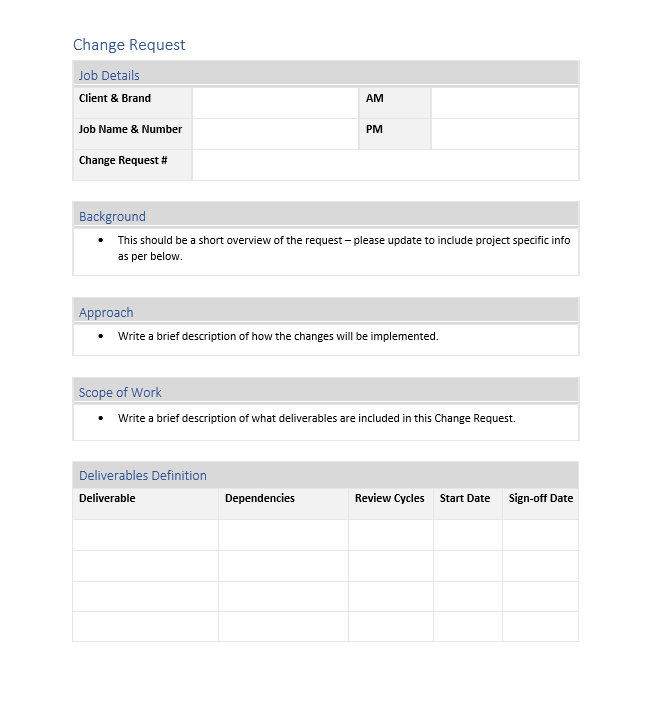
Change Request Template
Download our change request template, which helps you record the background, approach, scope, deliverables, assumptions, budget, dependencies, billing, and approvals for changes.
The Day-To-Day Process of Controlling Projects
As project managers, we follow a daily routine to ensure our projects stay on track. This requires that we know what’s going on. Sounds simple! But, in reality, project management is a constant cycle of processing information, planning, and making decisions.
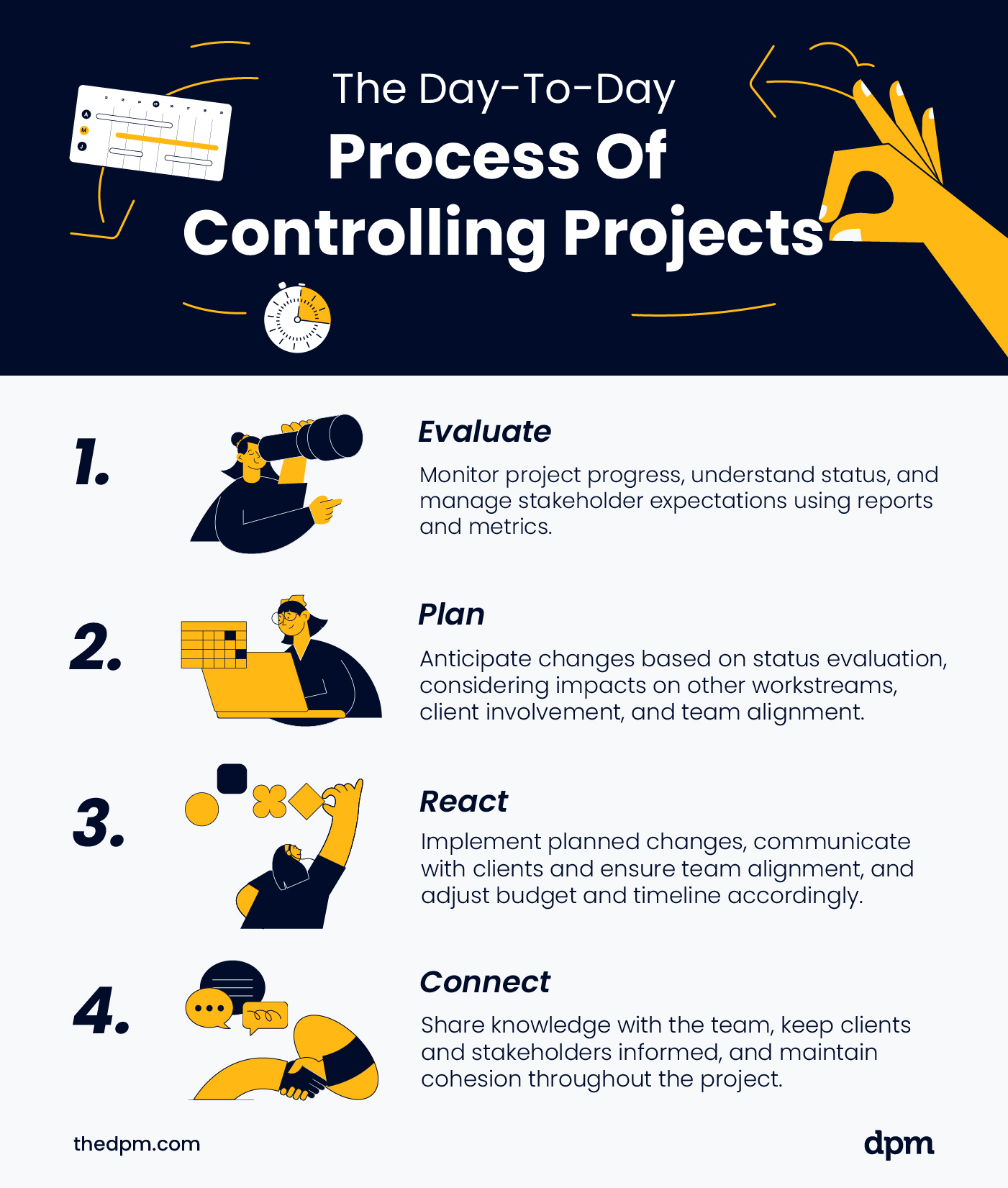
To keep things on track, project managers need to function like a radar system, pinging to see what’s ahead, and alerting everyone of the potential for impending disaster.
Effectively setting up a project control process enables you to keep an eye on cost and schedule as things evolve throughout the project. You will be expected to navigate your project through rough waters—being prepared will save your project from falling overboard.
To proceed, follow these four phases as part of a simple project control process:
Evaluate
Keep an eye on the project plan, the anticipated output, and the trajectory of the work. You must know where you stand so you can diligently manage stakeholder expectations. Ask questions to ensure you understand status. When you evaluate, use project status reports and metrics as a basis for decision making.
Plan
Based on the determined status, you’ll often need to implement course corrections. Ensure they are planned appropriately—try to anticipate where things are headed. Will a change affect other workstreams? Will you have to involve the client? Is the entire team on board? Is this a one-off, or do you see it becoming a bigger problem?
React
Once you have a plan, implement your changes. This includes letting the client know what’s changing and making sure the team is fully informed and on board. Know the impact to budget and timeline, and make the appropriate adjustments.
Connect
As a project manager, you’re the glue that holds the team together. Ensure that you distribute your knowledge to the team so that everyone gets the full picture. Keep the client and other stakeholders in the loop.
Follow up
Set reminders to follow up both internally and externally to avoid slippage.
Follow up with your team
We can’t assume that our team remembers every request or wise piece of advice that we give them. You have to dispense a lot of friendly reminders like “hey, sorry to be a pain, but did you get to X yet?” or “don’t forget about Y.”
Following up gives you some peace of mind that people are on track and also offers a quick pulse check on how things are going. It’s often during those brief check-ins that you’ll discover something isn’t quite going to plan.
Follow up with your clients or stakeholders
In part, following up with clients and stakeholders involves giving updates on project status—ie. what’s happening, what’s going to happen, and any issues.
But, it’s also similar to how we follow up with the team. It’s important to use these follow-ups to give friendly reminders on project timeline or any outstanding decisions that require client input.
Project Controls FAQs
Here are the answers to some frequently asked questions about project controls.
Where do project controls fit into the project life cycle?
By definition, project controls are a critical component of the monitoring and controlling phase of the project life cycle. That being said, many of the project control examples I discussed in this article should be developed during the project planning phase and made available during execution. Therefore, you could argue that project controls are used throughout the life cycle.
Is controlling the same as micromanaging my projects?
The biggest misconception about project controls is probably that you, as the project manager, need to control (ie. micromanage) your team to get the right results. But, that’s not the move.
Controlling in the form of micromanaging doesn’t take advantage of your team’s strengths and therefore risks taking the project off track (not to mention the burnout you’ll likely experience by trying to take on too heavy of a workload!)
Bottom line: project controls aren’t about directly controlling the work or the people who do it; they are intended to manage the structure and flow of the project itself.
What Do You Think?
A well-established and consistent project control process is the backbone for delivering projects on time and on budget. It also gives the team peace of mind that you, as their project manager, have got their back.
What are your experiences with project controls? Are there other project metrics that you measure? Share your experience or questions in the comments.


